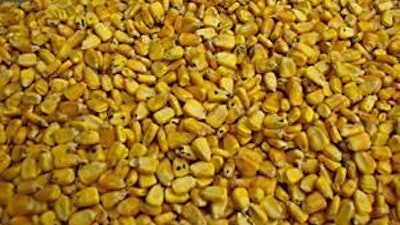
There’s good news and bad news about the 2009 corn crop.
Good news, first. Long after the stalks turned yellow and began to dry in U.S. corn fields, the USDA’s estimate for the total bushels of corn produced kept on growing. The estimate released in January and revised in March now has 2009 U.S. field corn production at 13.131 billion bushels, the largest crop ever, up substantially from estimates made during the growing season.
Now, the bad news. Wet weather during the summer and early fall in the Corn Belt helped to boost yields, but continued wet conditions in the late autumn and early winter slowed drying of the crop in the fields and delayed harvesting. As a result, published reports have claimed that last season’s corn harvest was the latest in living memory.
USDA reports
The USDA crop report released on March 10, 2010 still shows that nearly 8% of planted corn acreage had not been harvested by early February, primarily in states in the upper Midwest and in the Dakotas. Some of these unharvested acres will not be harvested, but published reports estimate that as many as 3 million acres of corn that were standing in fields in early March would still be harvested this spring.
The record size of the 2009 corn crop is good news for U.S. poultry and livestock producers who have seen the amount of corn used to produce ethanol increase at a rapid rate over the last decade. But, the wet weather conditions raise quality concerns for corn users.
Wet conditions in the fall raised the possibility of mold growth on the corn prior to harvest. After harvest, corn stored with high moisture levels has an increased risk of mold growth during storage. Corn left in the field through the winter in wet conditions also has a greater chance of harboring mold. Growth of mold reduces the feeding value of the corn and leads to mycotoxin contamination of the grain.
Mycotoxin survey
A February survey of corn samples from corn producing states conducted by Dairyland Labs, Arcadia, Wis., found significant levels of vomitoxin, aflatoxin, T-2 toxin and zearalenone in samples submitted from many states (see figure 1). Vomitoxin at levels from 0.1 to 49 parts per million was found in corn samples from Georgia, North Carolina, Kentucky, Pennsylvania, Ohio, Indiana, Illinois, Missouri, Iowa Michigan, Wisconsin, Minnesota, Nebraska and the Dakotas.
Aflatoxin at levels between 2 and 34 parts per billion was found in corn samples from North Carolina, Kentucky, Ohio, Indiana, Illinois, Wisconsin, Iowa, Minnesota and the Dakotas.
Several mycotoxins, including the ones found in the survey of this year’s corn crop, can have deleterious affects when present in the diet of livestock and poultry. Everything from reduced weight gain, increased carcass condemnations, reduced egg production, poor hatchability and abnormal feathering to decreased immune response have been documented for poultry fed diets with known levels of mycotoxins.
Surveys of mycotoxin contamination of feed also show that contaminated feeds seldom contain just one type of mycotoxin. Combinations of certain mycotoxins have been shown to increase the deleterious affects on the consuming animal beyond what would be expected based on the amount of the individual mycotoxins acting alone.
Coping with a suspect crop
Sampling corn and testing for mycotoxins when corn arrives at the feed mill is an important first step in minimizing the impact that mycotoxins can have in an operation. Rejecting loads of grain that do not meet specifications offers some level of protection. But, mycotoxins are not necessarily uniformly distributed throughout the truck or rail car load. If a hot spot exists in the load and it isn’t sampled, a contaminated load can get through. Also mycotoxins can be conjugated or “masked” by polar substances like glucose molecules. These conjugated mycotoxins will not be detected by routine testing methods but can become active in the gastrointestinal tract of the animal. Testing is only part of the solution.
During prior crop years when mycotoxin contamination was a particular concern, like in 1996, a lot of corn was treated with propionic acid which kills mold but leaves the mycotoxins unaffected. Also, some feed mills treated feeds made with suspect corn with clay-based compounds to try and bind the mycotoxins. Unfortunately, clay-based feed additives also can bind vitamins, some coccidiostats and some micronutrients in the feed.
Over the last few years, an alternative has been developed for treating feeds with potential mycotoxin contamination. Yeast cell wall extracts derived from the beta-D-glucans fraction have been shown to adsorb mycotoxins. Inclusion of these extracts in finished rations can bind mycotoxins and prevent their deleterious affects. Beta-D-glucans don’t bind to any other feed additives, like minerals or vitamins, and the mycotoxin-glucan bond is not affected by the pH of the gut of the animal.
Good practices
Wet weather in the Corn Belt contributed to the record corn crop last year, but it also contributed to mold growth and mycotoxin issues. Good grain receiving sampling and testing programs coupled with use of binders can help to keep the good news of a bumper corn crop from becoming a bad news mycotoxin contamination problem on your farms.


















